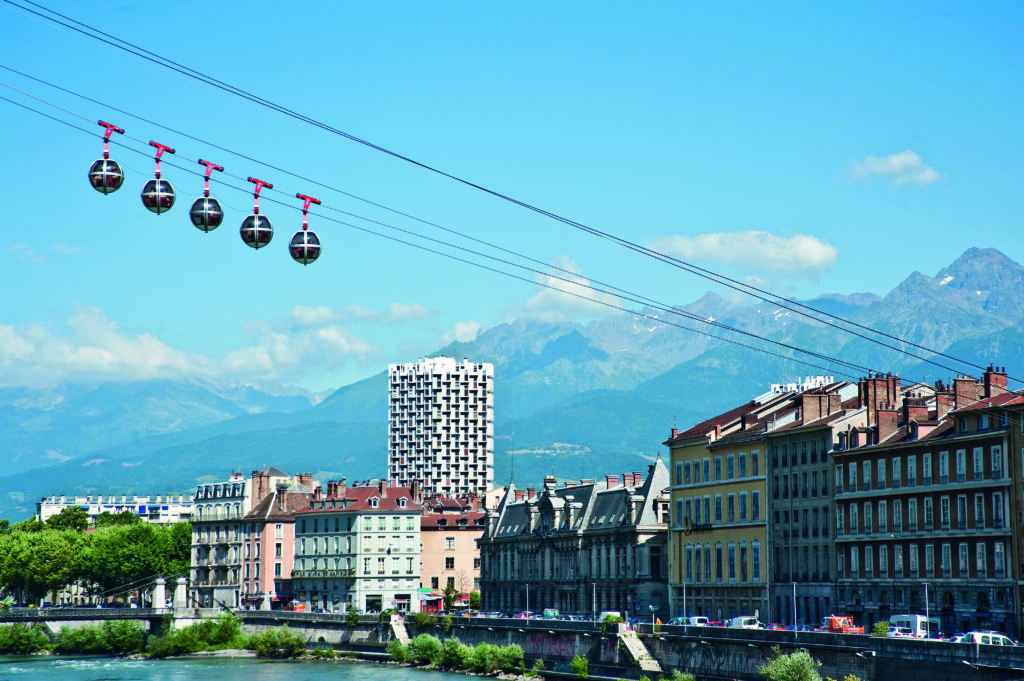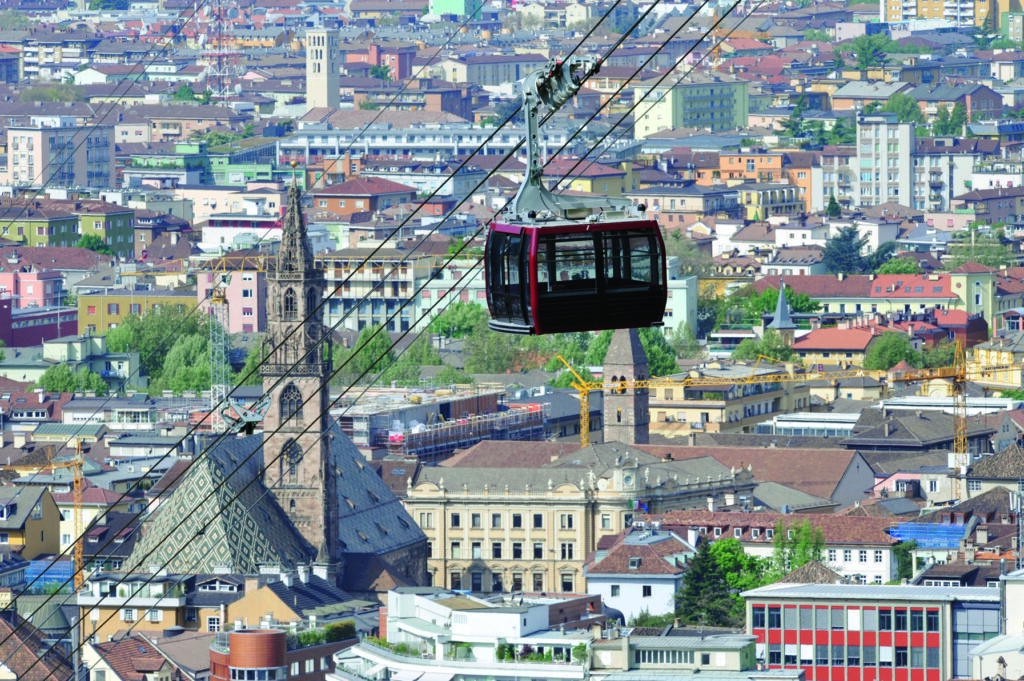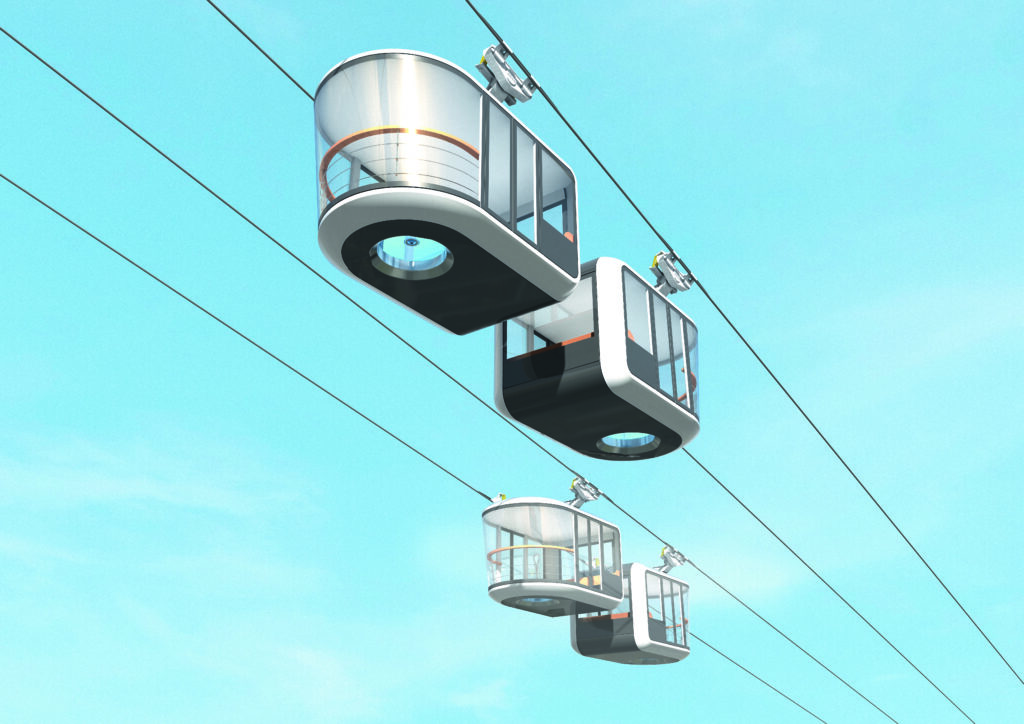Urban Cable- The Missing Link?
From the USA to Europe, from North Africa to Asia, the urban cable car is bringing the mountains to the city. The ability of this transit mode to span metropolitan sprawl to provide short and cost-appealing travel links is gaining credibility, traction, and proving an increasingly attractive complement to the metro, tram, and bus
staples of collective transport.
“Since 2012, there has been real momentum around the urban cable car, with 30 new and ‘serious’ well-advanced projects worldwide,” says Jacques-Jo Brac de la Perrière, from the association Ville et Transports Ile-de-France. The driving forces? The ability of cable to cross natural (hills and rivers) or man-made (roads or railway lines) features; to create interconnections; and to alleviate road congestion. Ecological reasons are cited too – thanks to their energy efficiency, the systems have an appealingly neat footprint. Since they generate less rolling resistance than land-bound transport, less electrical power is required to drive the cables. Furthermore, stop-and-go operations are energy sparing too. As an added extra, introducing this mode can help boost the appeal of a city (to both tourists and potential inhabitants), and its outlying districts.

The cost factor is a draw, too, with cable requiring less investment to build than its bigger sister modes: a one kilometer route costs around €40-50 million for a metro; between €15-25 million for a tramway; and €8-15 million for cable. And who can afford to ignore the conundrum currently faced by local and municipal authorities – the pressing need to expand their saturated transport networks on significantly reduced budgets.
3 Major Players
The supplier market for cable systems is dominated by three major players – the Italian Leitner; the Austro-Swiss Doppelmayr Garaventa; and the French POMA. For these firms, the market segment of urban cable represents a welcome business segment, enabling them to diversify from their core business for winter sports.
Nevertheless, together with the benefits come a number of technology- and infrastructure-related challenges. The route must be strategically planned – not only to provide the desired link per se – but also to link up as seamlessly as possible with other, existing modes. Will there be intermediary stations, and if so, how many and where? Getting the capacity and design of the cabins (or pods) right is equally important. Bearing in mind that city cable is not expected to carry the same volumes of passengers as the metro. Its urban role being to supplement existing modes, not replace them. Also station access for all, from street level to platform, must obviously be taken into consideration: if rapid and easy it will encourage riders; if not, they will travel other ways.

Last but far from least, let’s not overlook the safety and security aspects of the system, during boarding, alighting, and the journey itself. Can the doors be forced open? Is there an emergency stop button? Will stations be staffed or not? Is CCTV in operation?
Over the River Thames
Over- and underground, buses, Tramlink, Docklands Light Railway, taxis & minicabs, river, cycling, walking… and cable… London has brought another transit mode into its fold. The Emirates Air Line service – so called because it is sponsored by said airline – the first of its kind in the U.K., made its maiden ‘flight’ prior to the start of the Summer Olympic Games in 2012. Gliding 90 meters above the Thames River, the 1.1km line connects the O2 arena on Greenwich Peninsula with the ExCel Exhibition Center at Royal Victoria Docks. A complex construction project, it involved stretching 50- millimeter steel cables between steel towers 90-meters high.
Each cabin (34 in total) can carry 10 passengers, plus bicycles, and travels at a maximum speed of 6 meters per second (20 km/hr). Up to 2,500 passengers can be carried per hour, per direction, with the one way trip lasting 5 minutes at peak hours, and 10 minutes at other times (service speed is reduced).
The system forms part of the Mayor of London’s vision to regenerate the east of the city. Boris Johnson is keen to transform this area into a new metropolitan quarter boasting new businesses, tourist attractions, homes and employment opportunities. By providing the river crossing and introducing a landmark architectural addition to the cityscape, much more than passengers is riding on this cable service.
Changing Faces & Attitudes
In France, the Téléval cable project in Val-de-Marne (a department southeast of Paris) has been garnering attention among the national media. After languishing on the drawing board for the past five years, in September 2013 it was finally validated, although the necessary funding still appears to be outstanding. The area to be covered by this new transport system is cut up by rail tracks, a marshalling yard, roads, warehouses, and high-voltage lines. All of which leave little if any room to manoeuvre. Several options were explored when deliberating over how to supplement the existing, saturated, public transport offer.
One possibility was obviously to focus on the surface, for instance by restructuring and improving the existing bus network. Another option was to build a metro line underground, but this would have proved too costly and taken too long to complete. Finally, cable came up trumps by meeting all the key criteria, namely mobility needs, costs, and time to implement. The subsequent plan is to build a 4.5km long cable system, served by four to five stations. Designed to link up with one metro line and a number of bus routes, the estimated time gain for users will be 30 minutes of travel time less per day.
Not Over My Back Yard
Despite having gained acceptance in terms of function, there is still some way to go on Téléval’s form factor, particularly with regards to the urban insertion of pylons and stations. The irony is that in beautiful mountain settings, over the years ugly pylons have been inserted for cable cars but nobody seems to have protested; yet in the urban context there is public outcry. Always lurking at the back of minds is resistance to invasion of our ‘back yards’. The saying ‘a man’s home is his castle’ still holds true today – take the heated debate over the planned construction of a second, high-speed rail route (HS2) in Britain, for instance, and the French are no exception: “Today in France we are seeing strong resistance to the urban cable car,” reports Pierre Serne, vp, STIF & administrator, GART (French transport authorities), “just as we did in the early days of the tramway revival.”
The answer, Mr. Serne reckons, is for the system to be innovative, for sure, but equally to prove truly pertinent as a solution to the mobility problems experienced by the city district in question. “And here the Téléval project, with its plan for an efficient service and reduced journey times, is a case in point,” he adds. “If we can deliver these two elements, cable will be accepted by the public.”
Eyesight, Not Eyesore
Design undoubtedly has a part to play in gaining public acceptance. Not least by rethinking cable for its urban surroundings, rather than simply imposing the solid, functional mountain model on the city. And herein lies opportunities such as new kinds of pylons, and why not incorporate solar panels, too? The pods and cabins can become attractions in themselves, moving urban sculptures, with carefully chosen lighting and materials transforming them into a landmark and attraction. This has been the case with the Emirates Air Line in London, and is planned for the French coastal city of Brest. As Anna Katharina Rudolph from cable system supplier Doppelmayr points out: “It [the system] doesn’t have to look like a ski lift.”

Cable Knit for Brest
Apart from Paris, elsewhere in France, Toulouse, Grenoble, Marseille and Brest also have cable plans, some even more advanced. From this fold, the cable project in Brest, Brittany, which forms part of an ambitious urban development enterprise called “Capucins Brest”, is scheduled to enter into service during the second half of 2016. The 460-meter-long line, with terminal stations only, will cross the river Penfeld to link up its Right and Left Banks. “As is the case for many other cities with a large river running through them, Brest suffers from being effectively sliced in two,” points out project director Victor Antonio. Over the years, while the city center and economic activities developed on the Left Bank, the Right, formerly the naval, industrial district, was dedicated to ship-building. And although two bridges already span the Penfeld, they have long since reached saturation – a problem that is particularly irksome at peak travel times. “Currently, it takes 15 to 20 minutes to travel between the sides of the river, by car or tram,” explains Mr. Antonio. “But by cable it will take just three!”
We are convinced that cable transport is a mode for the future that will carve out its niche in the mobility chain; one that will meet the demand of local authorities wishing to develop their urban transport network,” stated Pierre Mongin, CEO, RATP. “Although we already have experience in cable transport, thanks to the Montmartre funicular [in Paris] and Salève cable system [Geneva, Switzerland], we wish to strengthen our our position and go further through this partnership.
In January 2015, French public transport group RATP and POMA signed a cooperation agreement for urban cable. According to the three-year understanding, the two partners will:
- share information on cable transport ventures – existing or planned – worldwide
- study opportunities for developing new projects together
- respond to consultations of interest to both parties in this particular field
Introducing the cable car into the urban public transport chain is not a trend, not a gadget, and not a panacea either
Joël Carreiras, city councillor, Toulouse
Weighing the Options
Like Conseil Général du Val-de-Marne, the municipal authorities of Brest opted for the aerial mode after taking all the other alternatives – transporter bridge, a road or pedestrian lift bridge – into consideration. Cable won the day for the following reasons:
- investment: at around €18 million, it worked out cheapest (the cost of each of the other options was estimated at between €20-60 million)
- environment: cable emits just 10 grams of C02 per person kilometer, compared to 17g for a tramway, 23g for a metro, and 76g for a bus
- reliability: cable is considered one of the most reliable modes of public transport
“If the system appeals to tourists by offering a vantage point over the city, we will consider this an added benefit,” points out Alain Masson, 1st vice president, Brest métropole océane (BMO), who nevertheless insists the link is designed first and foremost to cater for everyday journeys, such as going to work. Consequently, the ticketing system will be integrated into the city’s public transport network, and accept travel passes.
Open 358 days of the year until 1:00 am (opening times to be confirmed), the system will operate 19 hours a day, with a frequency of one cabin every five minutes, and a journey time of three. With a maximum capacity of 1,200 passengers per hour/per direction, 650 passengers are expected, estimates Brest Métropole.
Sky’s the Limit
Given interest from all sides – decision-makers, authorities, constructors (naturally!), city planners… urban cable may well prove its staying power in Europe’s city mobility chains. Obviously, the success of good projects will prove exemplary, paving the way for further developments. “Introducing the cable car into the urban public transport chain is not a trend, not a gadget, and not a panacea either,” says Joël Carreiras, city councillor, Toulouse, “but a question of the right mode for particular needs; needs such as efficiency, passenger numbers, modal switch, and social benefits.”
Making comparisons between the diverse urban cable links now dotting the globe is not necessarily a fruitful exercise. “It’s important too not to compare city to city – where each project has its unique characteristics and operating conditions,” advises Mr. Carreiras, “but rather assess how well the system would fit into a given modal mix.”